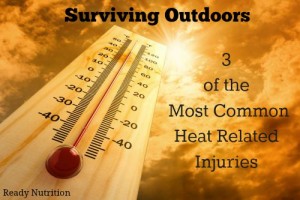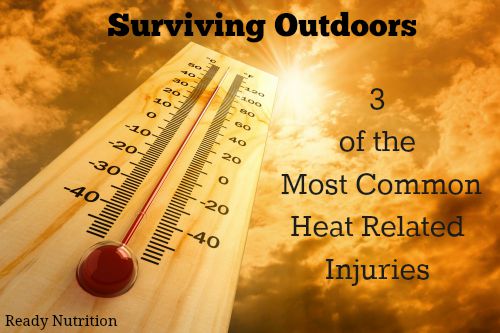[Editor’s Note: Heat-related illnesses come on rather quickly and are considered the #1 cause of weather-related deaths in the United States. Although this type of death is preventable, many who are unprepared succumb to extreme heat every year. Understanding the signs and symptoms of these types of medical emergencies, as well as having certain preparations [2] in order will minimize heat-related illnesses.]
Since spring has sprung, and summer is in full tilt, it would appear that summertime has the greatest chance to lay a person low with a heat injury. Let’s explore the types and the response to it, shall we?
The types of heat-related injuries are heat cramps, heat exhaustion, and heatstroke. Their signs and symptoms are as follows, along with the actions to be taken:
- Heat Cramps: Cramping in the extremities (arms and legs), abdominal (stomach) cramps, and excessive sweating.
Actions to be taken: Monitor the patient’s status (ask simple questions such as “What is your name?” or “Do you know where you are?” Move the patient to a cool, shady area. If one is not there naturally, then provide one. You can do this by stretching out a blanket at the four corners and tying them off on trees, etc., to provide shade. Loosen the patient’s clothing to enable the escape of heat and air circulation. Have them slowly drink at least a quart of water, and monitor them. Seek immediate medical attention if the cramps persist.
- Heat Exhaustion: profuse sweating with pale, moist, cool skin, headache, weakness, dizziness, loss of appetite, cramping, nausea (with or without vomiting), urge to defecate, chills (gooseflesh), rapid breathing, tingling of the hands and/or feet, and confusion (not answering easy questions correctly).
Actions to be taken: Monitor the patient mental status/simple questions. Move the patient to a cool, shady area or provide shade (as mentioned above). Loosen the clothing. Then pour water on the patient and/or fan him/her. Another thing that can be done (especially in the woods/a field environment) is taking a t-shirt or (if it’s available) a sheet, soak it with cool water, and apply this directly to the patient’s skin. The colder the water the better. This will have an extremely rapid effect of bringing the patient’s core body temperature down. Next have the patient slowly drink at least one quart of water. Monitor the patient until either the symptoms have left or until you can bring him/her to receive medical attention/emergency first responders arrive. The patient (even if the symptoms disappear) should not partake in any strenuous physical activity of any kind for at least the rest of the day. Monitor the patient for signs and symptoms of heatstroke!
Warning! This last condition (heat injury) is a medical emergency that may result in the patient’s death if there is any delay in first aid and/or definitive treatment!
- Heat Stroke: Red (flushed), hot, dry skin, weakness, dizziness, confusion, headache, seizures, nausea, stomach pains or cramps, respiration, and pulse may be rapid and weak, unconsciousness and collapse may occur suddenly.
Actions to be taken: Monitor the patient’s mental status. Move the patient to a cool, shady area or provide one if one does not exist. Loosen the patient’s clothing and footwear. Spray or pour water on the patient, and use a cooling sheet (as outlined prior). Massage the patient’s arms and legs. (Note: this step will allow blood to flow continuously to the extremities and back to the thorax). Elevate the patient’s legs. Slowly administer at least one quart of water to the patient if he or she has not lost consciousness. Closely watch the patient for any life-threatening conditions (if they should stop breathing, or if they suffer a heart attack). Seek immediate medical attention!
These actions are short, sweet, and to the point. One of the important things to remember in terms of treatment is the old saying, “An ounce of prevention is worth a pound of cure.” This holds true, especially with heat injuries. Know your limits and the limitations of family or group members when you are on an excursion somewhere. You need to stay hydrated at all times. Remember this rule: Thirst is a late sign of dehydration! What this means is that by the time you feel thirsty, your body is already depleted of water.
In a hot, physically-stressful/active environment, it is critical to stay hydrated and drink a minimum of one quart every hour to two hours, depending on your level of activity. Children and the elderly are, particularly at risk. It is strongly advisable to take with you beverages that contain electrolytes, such as Gatorade or Powerade that replace both fluid and electrolytes in an emergency such as a heat injury. Here is an article on how you can make your own electrolyte powders [3]. There is no shame whatsoever in protecting your body from any weaknesses that may arise from it being dehydrated.
Another thing that you need to do (especially in a group outing) is to monitor each other. Keep an eye out on the more vulnerable members of the group to ensure that thirst does not develop further into a heat injury. Take frequent rest breaks and do not push it too hard regarding your activities. In this way, you can maintain balance for everyone and ensure that all are up to speed for the fun that you have in the outdoors. No emergency is too small to not treat. Hope this information helps you out and have a safe trek and a good day!
JJ

